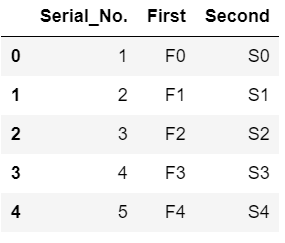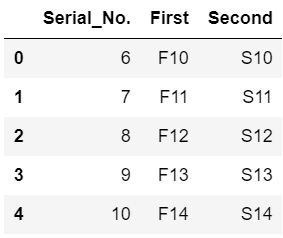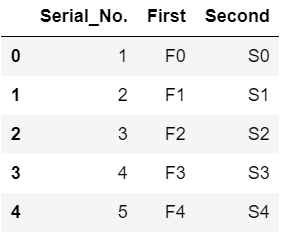将 DataFrame 与 Pandas 结合
Pandas DataFrame 由三个主要组件组成,数据、行和列。为了组合这些数据帧, pandas提供了多个函数,如concat()和append() 。
方法一:使用concat()方法
最初,创建两个数据集并将它们转换为数据帧。
Python3
# import required module
import pandas as pd
# making a dataset
data1 = {
'Serial_No.': ['1', '2', '3', '4', '5'],
'First': ['F0', 'F1', 'F2', 'F3', 'F4'],
'Second': ['S0', 'S1', 'S2', 'S3', 'S4'],
}
# creating a dataframe
df1 = pd.DataFrame(data1, columns=['Serial_No.',
'First',
'Second'])
# display dataframe
df1
# making a dataset
data2 = {
'Serial_No.': ['6', '7', '8', '9', '10'],
'First': ['F10', 'F11', 'F12', 'F13', 'F14'],
'Second': ['S10', 'S11', 'S12', 'S13', 'S14'],
}
# creating a dataset
df2 = pd.DataFrame(data2, columns=['Serial_No.',
'First',
'Second'])
# display dataset
df2Python3
# combining the two dataframes
df = pd.concat([df1, df2], ignore_index=True)
# display combined dataframes
dfPython3
# we can also separate 2 datasets using keys
frames = [df1, df2]
df_keys = pd.concat(frames, keys=['x', 'y'])
# display dataframe
df_keysPython3
# import required module
import pandas as pd
# making a dataset
data1 = {
'Serial_No.': ['1', '2', '3', '4', '5'],
'First': ['F0', 'F1', 'F2', 'F3', 'F4'],
'Second': ['S0', 'S1', 'S2', 'S3', 'S4'],
}
# creating a dataframe
df1 = pd.DataFrame(data1, columns=['Serial_No.',
'First',
'Second'])
# display dataframe
df1
# making a dataset
data2 = {
'Serial_No.': ['6', '7', '8', '9', '10'],
'First': ['F10', 'F11', 'F12', 'F13', 'F14'],
'Second': ['S10', 'S11', 'S12', 'S13', 'S14'],
}
# creating a dataset
df2 = pd.DataFrame(data2, columns=['Serial_No.',
'First',
'Second'])
# display dataset
df2Python3
# combining dataframes
result = df1.append(df2, sort=False, ignore_index=True)
# display combined dataframe
result输出:


现在,连接两个数据帧,我们将使用concat()组合两个数据帧。如果ignore_index = True df 的索引将是连续的。
蟒蛇3
# combining the two dataframes
df = pd.concat([df1, df2], ignore_index=True)
# display combined dataframes
df
输出:

使用键,我们可以指定数据帧的标签。
蟒蛇3
# we can also separate 2 datasets using keys
frames = [df1, df2]
df_keys = pd.concat(frames, keys=['x', 'y'])
# display dataframe
df_keys
输出:

方法 #2:使用append()方法
最初,创建两个数据集并将它们转换为数据帧。
蟒蛇3
# import required module
import pandas as pd
# making a dataset
data1 = {
'Serial_No.': ['1', '2', '3', '4', '5'],
'First': ['F0', 'F1', 'F2', 'F3', 'F4'],
'Second': ['S0', 'S1', 'S2', 'S3', 'S4'],
}
# creating a dataframe
df1 = pd.DataFrame(data1, columns=['Serial_No.',
'First',
'Second'])
# display dataframe
df1
# making a dataset
data2 = {
'Serial_No.': ['6', '7', '8', '9', '10'],
'First': ['F10', 'F11', 'F12', 'F13', 'F14'],
'Second': ['S10', 'S11', 'S12', 'S13', 'S14'],
}
# creating a dataset
df2 = pd.DataFrame(data2, columns=['Serial_No.',
'First',
'Second'])
# display dataset
df2
输出:


dataframe.append()方法执行合并两个数据帧的操作,类似于contcat()方法的操作。
蟒蛇3
# combining dataframes
result = df1.append(df2, sort=False, ignore_index=True)
# display combined dataframe
result
输出:
